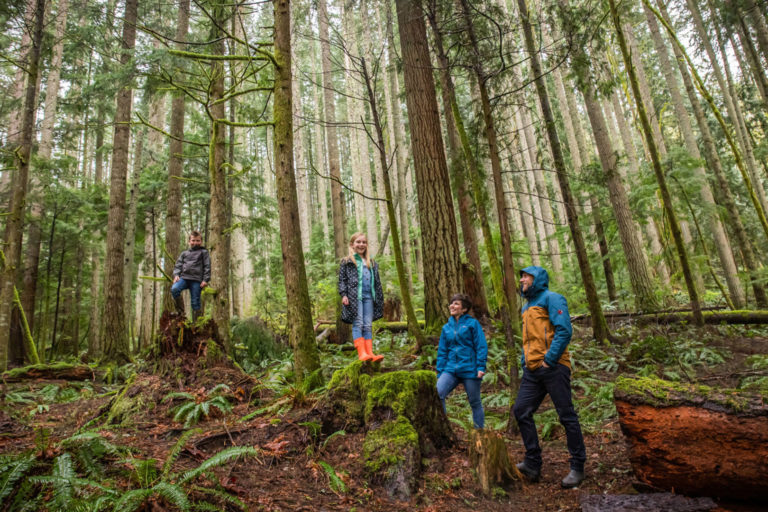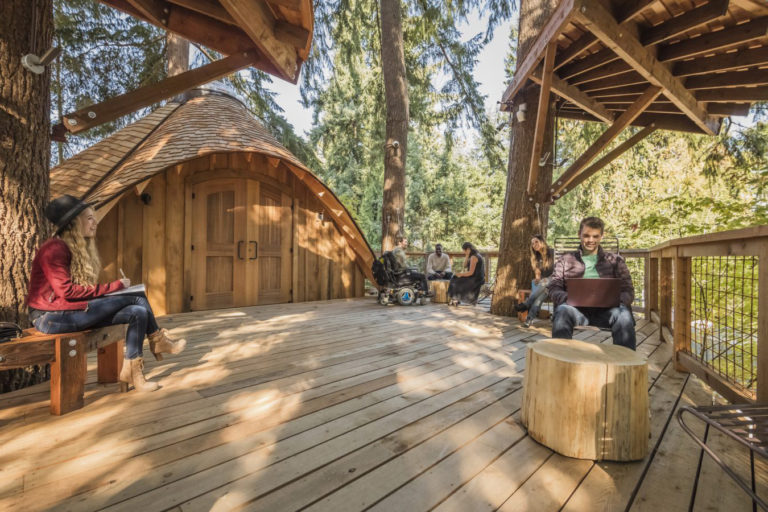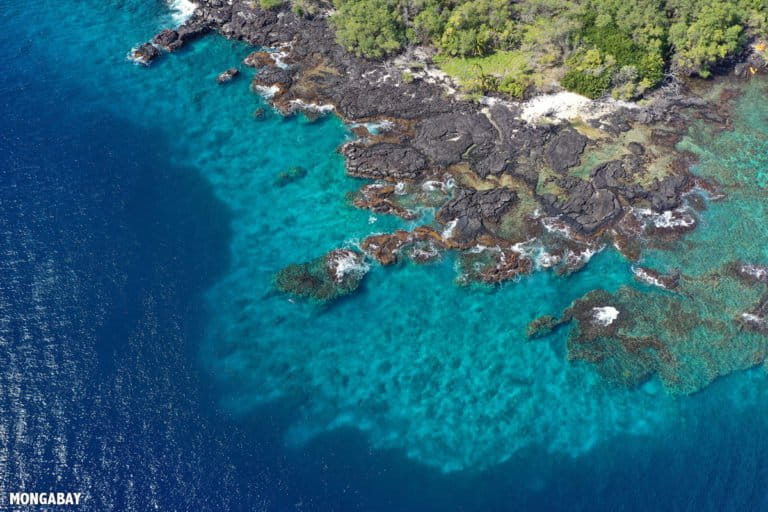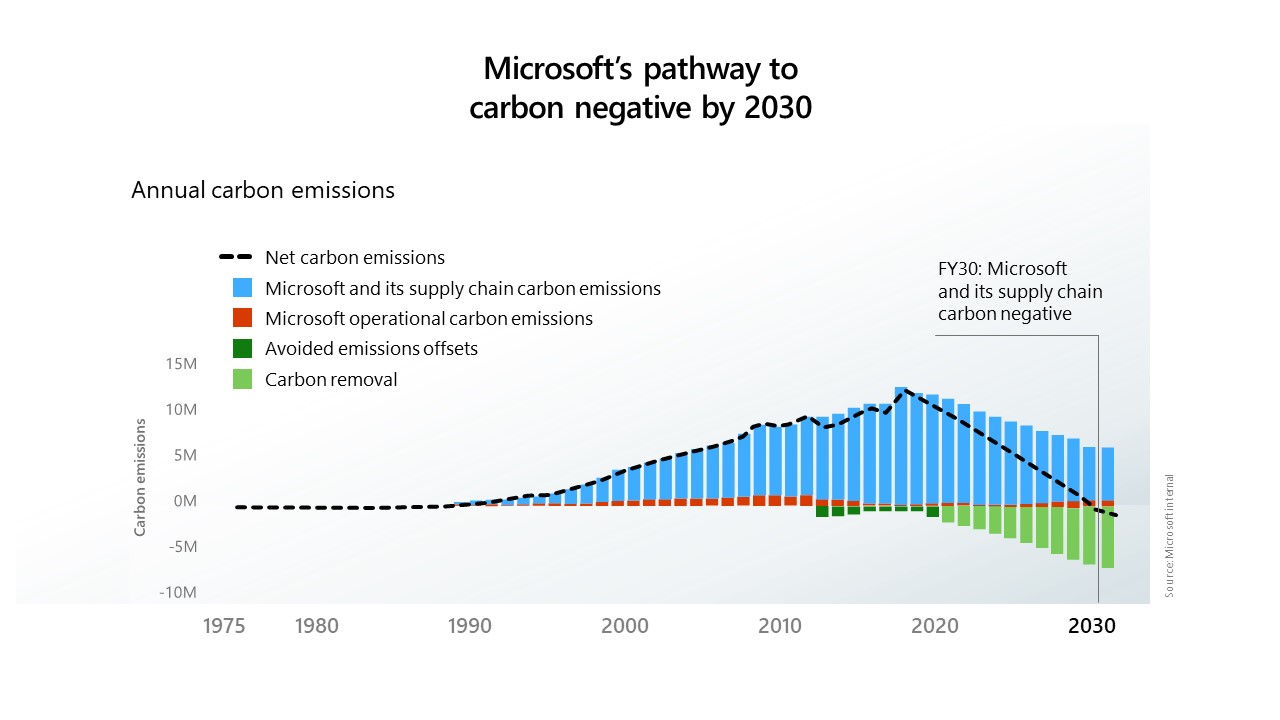Bold sustainability commitments: An interview with Microsoft’s Lucas Joppa
- One of the boldest climate commitments in 2020 came from the tech giant Microsoft, which in January pledged to be carbon negative by 2030 and to address its legacy emissions–all the carbon the company has emitted since its founding in 1975–by 2050.
- Microsoft has also committed to replenish more water than it consumes and produce zero net waste by 2030, while protecting more land than it uses by 2025. Further, the company said it would lend its computing power toward efforts to combat biodiversity loss and use its voice to advocate for public policies that “measure and manage ecosystems.”
- Heading up these ambitious sustainability initiatives is Microsoft’s chief environmental officer Lucas Joppa, a Ph.D. ecologist who also conceived of Microsoft’s AI for Earth platform.
- Joppa spoke with Mongabay Founder Rhett A. Butler in a December 2020 interview.
Despite the COVID-19 pandemic, 2020 has been the year of the climate commitment, with a number of companies and governments announcing plans to reduce carbon emissions by a specified level at some point in the future. One of the boldest commitments to date has come from the tech giant Microsoft, which in January pledged to be carbon negative by 2030.
But Microsoft didn’t stop there, the company also said it would “remove from the environment all the carbon the company has emitted either directly or by electrical consumption since it was founded in 1975” by 2050. In other words, Microsoft plans to zero out all of its historical carbon emissions.

Building on this carbon target, this year Microsoft further announced it will replenish more water than it consumes and produce zero net waste by 2030, while protecting more land than it uses by 2025. The company also said it would lend its computing power toward efforts to combat biodiversity loss and use its voice to advocate for public policies that “measure and manage ecosystems”.
Heading up these ambitious sustainability initiatives is Microsoft’s chief environmental officer Lucas Joppa.
 Joppa, who earned a Ph.D. in Ecology from Duke University and did two years of service in the Peace Corps in Malawi, got his start at Microsoft at the company’s research lab in the U.K., where he applied computer science to ecological questions. While there he proposed the AI for Earth program, which has since provided tens of millions of dollars in grants and technology to organizations and researchers working on environmental challenges. AI for Earth-supported projects have ranged from applying machine learning to recognize animal species to distilling satellite imagery into actionable information for conservationists.
Joppa, who earned a Ph.D. in Ecology from Duke University and did two years of service in the Peace Corps in Malawi, got his start at Microsoft at the company’s research lab in the U.K., where he applied computer science to ecological questions. While there he proposed the AI for Earth program, which has since provided tens of millions of dollars in grants and technology to organizations and researchers working on environmental challenges. AI for Earth-supported projects have ranged from applying machine learning to recognize animal species to distilling satellite imagery into actionable information for conservationists.
In mid-2018 Joppa was enlisted as Microsoft’s Chief Environmental Officer, where he’s responsible for its sustainability vision, strategy, and program execution. In that capacity, he’s served as the architect for the programs Microsoft rolled out this year.
Joppa spoke about his journey, Microsoft’s sustainability programs and ambitions, and the challenges and opportunities in addressing environmental challenges during a December 2020 interview with Mongabay Founder Rhett A. Butler.
This transcript has been lightly edited for clarity.
AN INTERVIEW WITH DR. LUCAS JOPPA
Mongabay: Well, thanks for joining me, Lucas. It’s a pleasure to see you again. I wanted to start out by asking how you got your start and what sparked your interest in the environment? And how did your career path unfold?
Joppa: Yes, sure. Thanks. And thanks for the opportunity. It’s great to see you again. A lot of people ask me where this all started for me and I honestly can’t pinpoint a time. So, I just say kind of at the beginning, I’ve always been interested in the environment. I’ve always when given the choice between being inside or outside, I chose outside. I’ve always been curious about kind of how it all works. When you go out in the woods, what are all these things and how do they get along and how do they fit together?
And then as I started to get a bit older and further in my studies, I started to ask that additional question, which I think has really defined the rest of my career, which is not just how does this all work, but what role the humans have in the system. What are the impacts that we’re having, and how can we get out ahead of reducing those negative impacts that we seem to be having over and over again on our natural systems? And obviously I care because it’s something I personally care about, but it’s also pretty clear that as a society, as a species, we have to care because we depend upon all of these systems for our very survival. So, it just seemed like something that matched my passion, matched my interest and was something that the world needed people to do. So, I decided to do it.

Mongabay: So, you made the jump from being in the world of academia to working in Microsoft. How was that transition for you?
Joppa: It was, I think, softer than a lot of people realize because I did come out of academia, and I did land in a large corporation. But I was pretty lucky in where I landed because I landed in the Blue-Sky Research arm of Microsoft, Microsoft Research. So, in many ways I continued to live this kind of interesting, or at least I thought it was interesting, academic life inside of a corporation. And so, I still was excited about writing papers, pursuing novel research and was rewarded for doing so, but I also had this additional lens to look at, which is how does all of this environmental science that I’m interested in integrate with a business? Why am I here? Why am I in Microsoft Research, leading research programs at the intersection of environmental computer science? And then over time that became more and more clear to me and I think to the company as to why.
Mongabay: Since you’ve stepped into that role your responsibilities have really grown. Earlier this year, Microsoft made a very bold commitment to become carbon negative by 2030. So, what prompted that decision and how is Microsoft actually going to implement that?
Joppa: Yes, it’s an interesting one because I left Microsoft Research. I left my kind of old research world behind to take on a more corporate job first as the first chief environmental scientist for the company, and then as the first chief environmental officer. And had the opportunity then to start thinking beyond just the academic research track and the innovation that we were investing in as a company, but really end-to-end across the corporation. How should we be thinking about our impact, our role in the broader fight to stabilize our climate systems, to ensure resilient water supplies, to reduce our exponentially increasing waste and exponentially increasing amount of species extinctions and ecosystem deterioration around the world.
The first thing that we did was step back, ask ourselves, are we doing enough in any of these areas? I think that any, self-aware person or organization that asked themselves that question on any topic in sustainability, the answer has to be absolutely not. Otherwise if we were doing enough, we wouldn’t be in the position that we are in today with respect to Earth’s natural systems and their degradation deterioration.
So, we stepped back and we said, we’re going to look at sustainability through the lens of four different areas, carbon, water, waste, and ecosystems. And we’re going to ask, what does the best available science say that the world needs to do? And then what would it mean for a company to do that? Or maybe what would it mean for a company to go even further than that? Because if you’re a company like Microsoft that has more resources than average, maybe you need to go further than average.
And so, we looked – your readers, your viewers, they know this as well as anyone. The best available climate science says that we need to transition to a net zero carbon economy by 2050. We need to do that by significantly reducing our overall emissions and investing in removal of CO2 directly from the atmosphere. So that’s what we said we were going to do. And we said that we’d do that.

We’d reduce our emissions by half or more. We’d remove the rest. And then we’d go beyond simply just balancing out the carbon accounts and we’d look retrospectively. And we would also commit to removing from the atmosphere as much carbon as we’ve emitted, since we were founded as a company in 1975. And that’s where the real carbon negative aspect comes in. I think that’s a really interesting opportunity to think about what any particular organization or other type of entity, geopolitical or otherwise, what its historical impacts have been and what it might be able to do to make amends for that.
Mongabay: A small part of reaching that climate target is investing in forest conservation. What does that look like and what does Microsoft look for when it evaluates conservation project?
Joppa: There are two different ways we are investing in forests and just nature in general. The first is through our carbon negative pledge. And I’ll talk about that in a second, but we also have three other kind of sustainability commitments, and one of them is also extremely relevant – well, two of them are also very relevant to the conversation around forests. And so, by 2030, what Microsoft is committed to doing is to be a carbon-negative water-positive zero waste company, that’s protecting more land than it uses and is building the foundations of what we’re calling a Planetary Computing Platform.
So, when you look at the investments that we need to make to be a carbon negative company that includes investments in what people call nature-based solutions for carbon removal, afforestation, reforestation, blue carbon, soil carbon sequestration. Basically, taking all of the incredible advances in biology that evolution has delivered to the world and harnessing them to do what a lot of nature does best, which is to sequester carbon or to consume in sequester carbon.

But there’s also a goal to protect more land than we use. And so that’s direct forest conservation projects in partnerships with the Nature Conservancy and National Fish and Wildlife Foundation here in the United States. But then there’s also our water positive goal, which means that we’re going to replenish more water than we use in all the regions that we operate.
One of the ways that you replenish water back into the hydrological basins in which you operate is by improving natural systems and improving their water retention and filtration processes, the whole kind of forest as a sponge, one thing.
So, when we look at forest investments that we’re making, we really first and foremost, look through the lens of what was the principal motivator of the investment. So, if that’s for carbon, as our carbon negative pledge, we’re looking at forests through their ability to provision carbon removal. If we’re looking at water replenishment, we’re looking at their water replenishment. If we’re looking at simple land-based conservation, we’re really looking for those opportunities to put land into a form of protection that really takes it above and beyond what it would have otherwise found itself. And obviously, we hope that the investments that we make are highly additional, that the protection and thus the preservation of the forest is directly as a result of the investments that we made. And then we look for other things, all of these ancillary dimensions that forest provide, species richness and biodiversity protection and the likes. But first and foremost, we look through the primary motivator of our investment, and then we take all of these kinds of additional considerations into account.
Mongabay: Taking a step back, earlier this month Microsoft signed The Climate Pledge. Do Microsoft’s efforts to reduce greenhouse gas emissions extend beyond its own operations?
Joppa: It does actually, and that’s where things get quite difficult. So, one of the things that we committed to in January when we made our carbon negative commitment was to say, “We are going to include our scope one emissions, which are our own direct emissions, whether that’s vehicles driving in our fleet or diesel generators as backup to our data centers. We’re going to include those emissions. We’re going to include our scope two emissions, which are the emissions associated with electricity that we use to power our offices and our data centers, as well as our scope three emissions. And scope three is basically everything else, all of our upstream supply chain associated emissions, our downstream value chain associate emissions, including the customer’s use of our devices.

When you look at the numbers in our portfolio, it’s about 100,000 metric tons, a year of emissions associated with scope one, about 4 million metric tons associated with scope two, and 12 million metric tons associated with scope three. So, that requires us to think really holistically across our entire business and spur broader corporate action, because we know that we need others to do better. Just like we need ourselves to do better if we’re going to meet some of our goals.
So, we signed the climate pledge because what the climate pledge is trying to do is to get more corporations to make significant climate pledges that are in line with achieving Paris and achieving Paris 10 years early. So, for Microsoft, we want to be that trusted technology provider of organizations as they go on their sustainability journey, but we need them to decide to go on that journey in the first place. And that’s a critical role that I think the climate pledge helps play.
Mongabay: What about Microsoft’s competitors? Does Microsoft benchmark its climate goals against competitors like Amazon and Google?
Joppa: No. I don’t think we benchmark our goals against Amazon and Google. We benchmark our goals against what the science says we need to do. Luckily, I think a lot of organizations are starting to do that. And so, you kind of end up with all of these organizations with really meaningful and powerful climate goals. Everybody is coming at the issue from a little bit different place because everybody’s businesses are a little bit different. And I think that that’s really important and super positive because what every business ultimately needs to do is to be able to put in score competencies, at least that’s what I call it, kind of core corporate competencies. What is it that makes you special as an organization?
For Mongabay, you have something that makes you special and a unique value add. For Microsoft, we do as well. It’s our products and our platforms and our services and our ecosystem of customers and partners around the world. For any of our competitors in the tech space, they have their own thing. And you see everybody trying to say, “Okay, we need to make these meaningful commitments.” For Microsoft is to be a carbon negative company. But it’s also to say, “What is relevant about our business, our business model than our products that can help others achieve that?”
So, I would just highlight two things here. One is our, our ecosystem approach at Microsoft. We exist to empower others to achieve more. And one of the things that we did back in June is we came together with nine leading companies with long histories of investments in sustainability, and some of the most meaningful corporate climate commitments in the world. And we committed to working together to put in place all of the roadmaps and guidebooks for any corporation to be able to easily and efficiently go and achieve their own climate goals. So that’s kind of taking advantage of our business model and our ecosystem.

Then when you look at the kind of the technology side, you see a lot of that instantiated in our commitment to build this thing that we’re calling the planetary computer which is really an integration of the cloud scale compute globally important environmental data sets, and then building out kind of the programming environments, the machine learning training environments, and investments in some application areas, so that partners all around the world can take advantage of the technology platform, the cloud platform that Microsoft provides in a much more easy fashion. And we learned a lot of what we’re investing in today through a program that you know well called AI for Earth, which was a really kind of a toe into the water of learning what the needs are and the gaps are at the intersection of AI and machine learning, cloud computing, and environmental conservation.
Mongabay: On the AI for Earth topic, what do you see as the biggest opportunities for driving large-scale environmental outcomes from the technology standpoint? And among those gaps and opportunities, what would you say are the technological areas you’re most excited about right now?
Joppa: The biggest opportunity in my mind is really simple to say, really difficult to achieve, and it’s just making it easier for people to take advantage of the scalable compute infrastructure that the cloud provides. It’s unfortunate, but it’s true that you still need to know way too much to be able to really use cloud scale computing in anger or an earnest, whatever your favorite way of turn of phrase is.
We know that most environmental scientists didn’t graduate from top computer science departments. They graduated from top environmental science department, so they found their skills elsewhere. So that’s really where the planter computer investments come from is just saying, “There’s really like this missing layer in the tech sector. This layer that still needs to get built out in order for environmental organizations, practitioners to really easily just be able to reach in and grab some of these technologies that they need.”
I would argue that the technologies they need are really focused in four key areas. There’s kind of what I would call classification, just asking the simple question is what is where? We still struggle with that as you know better than most. Just understanding the state of our natural systems is tough, and a huge impediment in better managing natural resources.

The second is forecasting. Some ability to make a prediction about what’s going to happen next is critical. And then there’s optimization, which is given that we give it now, if we can help people understand what is where and how much is there and how fast it’s changing, the classification and the forecast and component, then we can ask these other questions, which is, what could be there and what should be there and how should we allocate that land and water optimally under those different uses? Different categories of protected areas, for instance, different types of land use zoning.
Then of course, the last bit is really around diagnostics, which is, “I made an investment, I performed some sort of intervention. Maybe I created a protected area. Maybe I invested in the preservation of some critically endangered species. What was the impact of that?” That kind of that counterfactual estimation, the additionality calculations. Those are also work streams that we want to support.
So those are the four areas that I’m super excited about getting out and trying to close that technology availability gap, classification, forecasting, optimization, and diagnostics. And then I think you’ll start to see some partnerships that we’re starting to set, people building really stuff on top of those building blocks.
Mongabay: What have you seen or heard about the impact of COVID both with AI for Earth partners, but also generally in the sector. How is COVID changing priorities and creating the opportunities?
Joppa: It’s been such an interesting year in so many ways, everybody is acutely aware of that. What I think has been interesting – we’ve heard some anecdotal things that make sense. I guess a lot of the organizations that we work with that do protection work in particular are seeing a lot higher levels of encroachment just because as the economy drops out, as tourism drops out in some of these really important places, the eyes aren’t necessarily there on the ground and the dollars aren’t necessarily easily found elsewhere in the economy. And so, kind of, as you expect, I think you start seeing a little bit more lawlessness on the ground, which is unfortunate.
But I think what it’s starting to drive in the AI for Earth space, the conservation space, is similar to what it’s driving more broadly across all sectors of the economy, which is a demand for more automated, scalable tools. Transportation options are limited, travel’s limited, just being out and about and around people is not an easy thing to do, but we still want to be monitoring and managing these natural systems. And so, whether that’s remote sensing from above, from satellite and other forms of aerial imagery to kind of in situ monitoring of camera traps, acoustic recorders, and things like that inside protected areas. We’re seeing demand for those types of solutions go up quite a bit.

We’re also seeing a lot of interest in people finally getting around to analyzing the incredible amounts of data that they’ve been collecting through field season, after field season, after field season, putting all this instrumentation out into the wild, but then never really having the time to step back and actually ask how they’re going to analyze it because they’ve got their next field season. What we just lost in field seasons and people are finding themselves in front of their computers and finally getting around to, “All right, I need to plough through millions of images now. What tools are available to me?” So, we’re starting to see a lot of, kind of increase in demand for the types of tools that the AI for Earth Grants’ are building, which is fantastic.
Mongabay: What kind of advice would you give someone aspiring to pursue a career at the intersection of conservation and technology?
Joppa: It’s a great question. It’s a hard one for me to answer because I’m not sure that my trajectory is one that many should emulate. I came out of much more of a pier ecology track than a mixed technology and ecology track. And I’m not sure that if I had to go and purposely design my career would be how I would do it, but I would just say that those that I see bringing the most value to any environmental conversation are those that bring a level of depth and breadth that isn’t shared within whatever room they’re operating in.

So being able to bring engineering skills to the party, but also understanding the subtleties, the nuances of the environmental problems that need to be addressed, those kinds of what I would call market makers. Those that can see both sides. The world’s got plenty of engineers. The world’s got plenty of environmental scientists. I think anytime you put engineers and environmental scientists in a room together, you think my kingdom for a horse here. If there was just one person that was able to easily and agilely bring these two sides together and efficiently get them working well together towards a singular common and impactful purpose, then that’s really the skill that we’re looking for.
So, yes, you need some of the fundamentals on the technology side. You need the fundamentals on the environmental side, but it’s really, I think those opportunities to step back and just broaden your experience about what the needs are, what motivates each side, the way they think, the business pressures they might be under all to be able to just bring people together in a much more collaborative fashion is super important.
Header image: California pine forest. Photo by Rhett A. Butler.
Mongabay received a one-year grant from Microsoft’s AI for Earth program in 2018 for the WildTech reporting initiative. Microsoft did not have editorial influence on Mongabay’s reporting.



